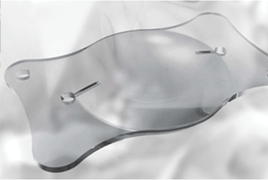Purpose: The aim of the study was evaluation and comparison of rotational stability and the effect of multifocal toric intraocular lens rotation (T-MIOL) at visual quality of two types of intraocular lens AcrySof IQ ReSTOR Toric SND1Tx (Alcon Laboratories, Inc.) and AT LISA toric 909M (Carl Zeiss Meditec AG). There was evaluated a pseudophakic dysphotopsia based on patient’s subjective feelings as well as the independence on glasses and overall satisfaction with the visual quality after T-MIOLs were implanted.
Methods: The retrospective study included 68 eyes (100 %) of 34 patients, who underwent an uncomplicated cataract surgery with multifocal toric intraocular lens was implanted. 68 eyes were divided into two groups. Group A consisted of 48 eyes (70,6 %) with AcrySof IQ ReSTOR Toric SND1Tx and group B included 20 eyes (29,4 %) with AT LISA toric 909M multifocal toric intraocular lenses were implanted. The T-MIOL position, planned axis and misalignment were evaluated one week and 6 months after surgery. Surgical lens reposition was indicated in case of worsening visual quality due to T-MIOL rotation from its planned position.
Results: In the group of 68 eyes, the mean uncorrected distance visual acuity (UDVA) before surgery was 0,08 (n = 48) in group A and 0,09 (n = 20) in group B. The mean UDVA after T-MIOL were implanted improved to 0,83 ± 0,06 (n = 48) in group A and 0,75 ± 0,08 (n = 20) in group B. The mean UDVA in patients before T-MIOL surgical rotation was 0,57 ± 0,03 (n = 5) in group A and 0,59 ± 0,08 (n = 5) in group B. At six months after T-MIOL surgical rotation, the uncorrected distance visual acuity was 1,0 in both groups (p = 0.70). The surgical rotation of T MIOL was performed in 10 eyes (14,7 %) of 68 eyes (p = 0.48), in group A (n = 48) in 5 eyes (10,4 %) and in group B (n = 20) in 5 eyes (25,0 %). Mean deviation from the planned axis was 8,2 ± 1,78 degrees in group A and 13,4 ± 3,04 degrees in group B. At six months postoperatively, the T-MIOL rotational stability showed less than 5 degrees for all surgically rotated lenses in both groups. Mean cylinder decreased in all patients from -2,92 ± 1,85Dcyl to -0.85 ± 0.61Dcyl after surgery. The mean spherical equivalent for all patients decreased from 0,56 ± 4,75D to 0,06 ± 1,33D after surgery. Presence of disturbing fotic phenomenon had reported 11 (32.4 %) of 34 patients, 9 of them they were subsequently indicated T-MIOL reposition. All 34 patients were able to perform normal daily tasks independently on spectacle correction. At six months after surgery, there was very high satisfaction with the quality of postoperative
vision in both groups.
Conclusion: Implantation of toric multifocal intraocular lens, both of AcrySof ReSTOR Toric SND1Tx (Alcon Laboratories, Inc.) and AT LISA toric 909M (Zeiss Meditec AG Carl) in cataract patients is safe and effective method to correct corneal astigmatism and maintain the visual multifocality. Early surgical T-MIOL reposition should be performed to put the T-MIOL to planned axis in steepest meridian if unwanted lens rotation is identified.

